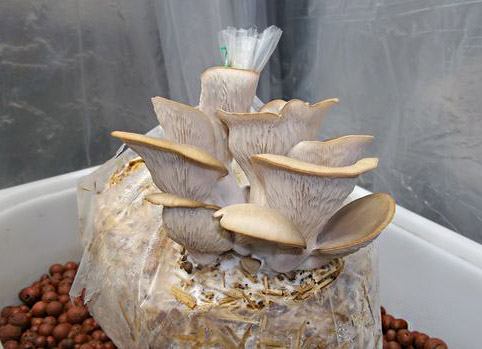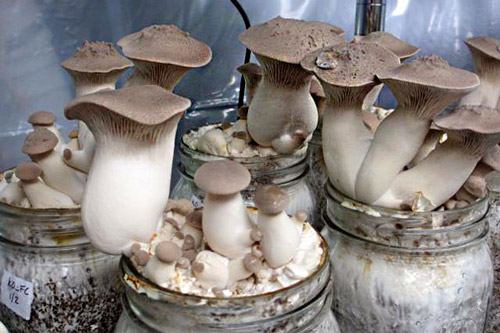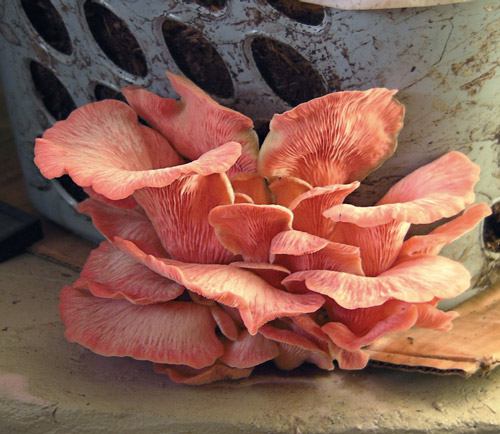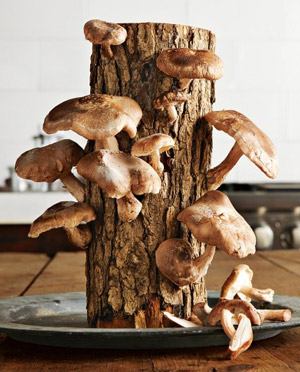Growing mushrooms on straw is one of the simplest and most effective methods for home cultivation . Straw is inexpensive, readily available, and nutritious. Moreover, straw substrate is quite versatile. It’s loved by oyster mushrooms, honey mushrooms, the Garden Giant, and most mushrooms grow successfully on straw. If you’re growing mushrooms for the first time, try using straw. The home cultivation method in a laundry basket also uses straw substrate.
 Oyster Mushrooms on Straw Substrate
Oyster Mushrooms on Straw Substrate
How to Grow Mushrooms on Straw
Before inoculating the straw, it must be prepared. Straw contains the microflora of other fungi and molds, which will compete with the mycelium for nutrients and may prevail. Therefore, straw needs to be sterilized. There are several methods to prepare straw, starting with pasteurization.
Pasteurizing Straw
Usually, after pasteurization, a small number of beneficial bacteria remain. The straw should be cut into pieces 5-10 cm long. Smaller pieces colonize faster, and working with chopped straw is much easier.
Pasteurization occurs at 60-80°C. Soak the straw in boiling water for an hour. General recommendations:
For small amounts of straw:
- Fill a metal bucket or pot halfway with water. Bring the water to a boil and let it cool slightly. A cooking thermometer will be very useful here.
- When the water reaches approximately 70-80°C, try to maintain this temperature.
- For convenience, it’s advisable to load the straw into a nylon mesh (like for washing delicate items), but this is not necessary. Use as much straw as your pot can hold.
- Submerge the straw in the water. Ensure that all the straw is covered by water. Monitor the temperature and water level, and let the straw soak for an hour.
- After an hour, remove the straw and let it drain and cool to room temperature. Once the straw is cool, inoculate it with mycelium.
Cold Incubation
This method works for cold-loving mushrooms.
- Soak the straw in water for an hour, let it drain but not dry out.
- Mix the straw and mycelium in a container, bag, or box – anywhere, but use more mycelium than usual.
- Cover the containers with a film and place them in a cool place, at temperatures from 1 to 10°C. Monitor the mycelium – when the containers are well-colonized, provide higher temperatures for mushroom growth.
I found only a couple of types of mushrooms that work under these conditions – oyster mushrooms, honey mushrooms, and chanterelles. In any case, when choosing a mushroom for cultivation, pay attention to its preferred temperatures. The cold incubation method is less effective than pasteurization but requires less effort.

Hydrogen Peroxide Sterilization
This method is considered dubious, but it exists and is used. Hydrogen peroxide effectively kills pathogens in the straw but does not affect the mycelium (so it is said).
- Soak the straw in water for an hour. Rinse it under running water twice.
- Soak the straw in a solution of peroxide and water (1:1) for several hours (up to a day).
- Drain and rinse the straw several times, then inoculate it.
If you have access to a large amount of peroxide and heating water would cost too much, consider this method.
Other Methods of Straw Sterilization
- Steaming the straw over a steam bath.
- Dry heat.
Use an oven at a low temperature. Load the straw into a baking bag and place it in the oven for an hour at 70-80°C. The straw should then be soaked in boiling water for an hour.
If you don’t want to deal with straw, just don’t use straw substrate. Choose to grow on logs or cardboard. Try alternative substrates like coffee grounds. They are already sterilized and very nutritious. For the first time, you can also buy pre-pasteurized straw. I’ve read a lot, and besides logs, straw is highly praised.
Moving on to the next step. Before mixing the mycelium with the straw, make sure it has cooled to room temperature.
What you need:
- straw
- mycelium
- sturdy polyethylene bags, cleaned with peroxide or alcohol (you can use various containers to fill with straw, whatever your imagination allows)
- A sharp tool for making holes in the bag (boiled)
- rubber bands or ties
If your mycelium is compressed, crumble it and mix with the straw in a clean container. Do it as your heart dictates – it’s not an exact science. Fill the bags with the freshly prepared straw, don’t pack it too tightly. But try to remove all the air from the top.
Make holes in the bag at a distance of 10-12 cm from each other – the mushrooms will grow out of these holes.
Waiting for the Harvest
This article doesn’t provide exact recommendations for temperature, light, and humidity. It varies for each species, so it doesn’t fit into a single article.
Initially, your bags should be kept in a dark, cool place (15-17°C). This temperature is preferred by most species. If the straw seems to dry out, mist it through the holes. Don’t overdo it with moisture.
Within 2-8 weeks, the bags should turn white, and small mushroom pins may start to appear through the holes. At this point, move the bags to a shaded area with minimal UV exposure.
Harvest the mushrooms when the caps start to turn upwards (for oyster mushrooms). Mist the mushrooms daily. One bag can yield 2-3 flushes, depending on the quality of the straw, mycelium, bag size, and mushroom species… If you notice mold in the bag, it’s time to say goodbye to the bag!
It may seem complicated and pointless since mushrooms are easier to buy. But it’s very interesting, and for me, the thrill of being a researcher is of immense value. I hope it is for you too!
A Few Recommendations
Do not allow standing water in the bags. If you notice it, make a hole in the bottom to drain excess moisture. It’s harder to over-dry than over-moisten, but it can still happen – check the substrate daily. Most edible mushroom mycelium is white. If you see red, green, black, brown, or blue areas – that’s mold. Discard the bag. But if you’ve properly sterilized the straw and bag, and worked with clean hands and tools, everything should be fine.
Keep the bags away from cat litter boxes and trash bins. Bacteria from these places can spoil the mycelium and cause rot.
Do a bit of research on the mushroom species you plan to grow. If you’re growing mushrooms for the first time, prepare just one or two bags. Even if the first attempt doesn’t succeed, the losses won’t be significant, and you might still want to try again.




